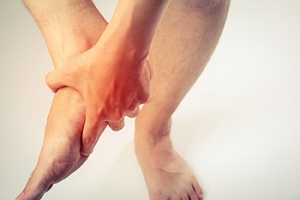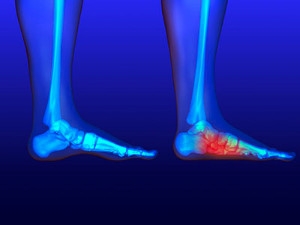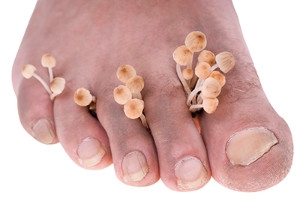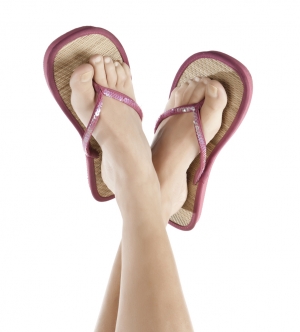Featured Articles

Possible Methods to Find Relief from Foot Pain
 Patients who have chronic foot pain are familiar with the discomfort it can cause. Completing daily activities may be challenging as a result of the dull aches or shooting pains that are present in the feet. There are several reasons why pain in the feet may occur. These include fractures, plantar fasciitis, or Achilles tendonitis. There are methods that can be implemented which may provide mild relief. Many people have found it beneficial to lose weight, as this may help to reduce stress on the joints in the feet and toes. Additionally, it is worthwhile to perform proper stretching techniques which can help to diminish the risk of injury. Receiving regular massages may aid in managing chronic foot suffering, and wearing shoes that are comfortable can ease the pain. If you have pain in your feet, it is suggested to consult with a podiatrist who can properly treat any type of foot affliction.
Patients who have chronic foot pain are familiar with the discomfort it can cause. Completing daily activities may be challenging as a result of the dull aches or shooting pains that are present in the feet. There are several reasons why pain in the feet may occur. These include fractures, plantar fasciitis, or Achilles tendonitis. There are methods that can be implemented which may provide mild relief. Many people have found it beneficial to lose weight, as this may help to reduce stress on the joints in the feet and toes. Additionally, it is worthwhile to perform proper stretching techniques which can help to diminish the risk of injury. Receiving regular massages may aid in managing chronic foot suffering, and wearing shoes that are comfortable can ease the pain. If you have pain in your feet, it is suggested to consult with a podiatrist who can properly treat any type of foot affliction.
Foot Pain
Foot pain can be extremely painful and debilitating. If you have a foot pain, consult with one of our podiatrists from Romeo Foot & Ankle Clinic. Our doctors will assess your condition and provide you with quality foot and ankle treatment.
Causes
Foot pain is a very broad condition that could be caused by one or more ailments. The most common include:
- Bunions
- Hammertoes
- Plantar Fasciitis
- Bone Spurs
- Corns
- Tarsal Tunnel Syndrome
- Ingrown Toenails
- Arthritis (such as Gout, Rheumatoid, and Osteoarthritis)
- Flat Feet
- Injury (from stress fractures, broken toe, foot, ankle, Achilles tendon ruptures, and sprains)
- And more
Diagnosis
To figure out the cause of foot pain, podiatrists utilize several different methods. This can range from simple visual inspections and sensation tests to X-rays and MRI scans. Prior medical history, family medical history, and any recent physical traumatic events will all be taken into consideration for a proper diagnosis.
Treatment
Treatment depends upon the cause of the foot pain. Whether it is resting, staying off the foot, or having surgery; podiatrists have a number of treatment options available for foot pain.
If you have any questions, please feel free to contact our offices located in Washington and Shelby Townships, MI . We offer the newest diagnostic and treatment technologies for all your foot care needs.
Foot Pain
The feet, being the foundation of the body, carry all of the body’s weight and are therefore prone to experiencing pain and discomfort. If you are experiencing foot pain, it is important to determine where in the foot you are experiencing this pain to help discover the cause of it. While pain can be experienced virtually anywhere in the foot, the most common sites of foot pain are in the heel and ankle.
Heel pain can be due to a multitude of conditions including plantar fasciitis, Achilles tendinitis, and heel spurs. Pain experienced in the ankle can be a sign of an ankle sprain, arthritis, gout, ankle instability, ankle fracture, or nerve compression. In more serious cases, pain in the foot can be a sign of improper alignment or an infection.
Foot pain can be accompanied by symptoms including redness, swelling, stiffness and warmth in the affected area. Whether the pain can be described as sharp or dull depends on the foot condition behind it. It is important to visit your local podiatrist if your foot pain and its accompanying symptoms persist and do not improve over time.
Depending on the location and condition of your foot pain, your podiatrist may prescribe certain treatments. These treatments can include but are not limited to prescription or over-the-counter drugs and medications, certain therapies, cortisone injections, or surgery.
If you are experiencing persistent foot pain, it is important to consult with your foot and ankle doctor to determine the cause and location. He or she will then prescribe the best treatment for you. While milder cases of foot pain may respond well to rest and at-home treatments, more serious cases may take some time to fully recover.
Are Flat Feet Painful?
 Patients who have minimal or absent arches have a condition that is referred to as flat feet. This condition is also known as fallen arches. The majority of babies are born with flat feet, and the arch typically develops as walking begins and the feet become stronger. Additionally, there may be existing medical conditions which may include diabetes, rheumatoid arthritis, and obesity that can lead to flat feet. Some of the symptoms that are associated with this condition often include the shoes wearing out at an accelerated pace, frequent discomfort, and the feet feeling weak or stiff. Mild relief may be found when proper foot stretches are performed, and when the correct footwear is worn. If you have flat feet, it is suggested to counsel with a podiatrist who can address any concerns you may have.
Patients who have minimal or absent arches have a condition that is referred to as flat feet. This condition is also known as fallen arches. The majority of babies are born with flat feet, and the arch typically develops as walking begins and the feet become stronger. Additionally, there may be existing medical conditions which may include diabetes, rheumatoid arthritis, and obesity that can lead to flat feet. Some of the symptoms that are associated with this condition often include the shoes wearing out at an accelerated pace, frequent discomfort, and the feet feeling weak or stiff. Mild relief may be found when proper foot stretches are performed, and when the correct footwear is worn. If you have flat feet, it is suggested to counsel with a podiatrist who can address any concerns you may have.
Flatfoot is a condition many people suffer from. If you have flat feet, contact one of our podiatrists from Romeo Foot & Ankle Clinic. Our doctors will treat your foot and ankle needs.
What Are Flat Feet?
Flatfoot is a condition in which the arch of the foot is depressed and the sole of the foot is almost completely in contact with the ground. About 20-30% of the population generally has flat feet because their arches never formed during growth.
Conditions & Problems:
Having flat feet makes it difficult to run or walk because of the stress placed on the ankles.
Alignment – The general alignment of your legs can be disrupted, because the ankles move inward which can cause major discomfort.
Knees – If you have complications with your knees, flat feet can be a contributor to arthritis in that area.
Symptoms
- Pain around the heel or arch area
- Trouble standing on the tip toe
- Swelling around the inside of the ankle
- Flat look to one or both feet
- Having your shoes feel uneven when worn
Treatment
If you are experiencing pain and stress on the foot you may weaken the posterior tibial tendon, which runs around the inside of the ankle.
If you have any questions please feel free to contact our offices located in Washington and Shelby Townships, MI . We offer the newest diagnostic and treatment technologies for all your foot and ankle needs.
Flat Feet
Flatfoot is a condition that occurs when the arches on the foot are flattened, which allows the soles of the feet to touch the floor. Flatfoot is a common condition and it is usually painless.
Throughout childhood, most people begin to develop arches in their feet, however, some do not. Those who do not develop arches are left with flatfoot. The pain associated with flat feet is usually at its worse when engaging in activity. Another symptom that may occur with those who have this condition is swelling along the inside of the ankle.
It is also possible to have flexible flatfoot. Flexible flatfoot occurs when the arch is visible while sitting or standing on the tiptoes, but it disappears when standing. People who have flexible flatfoot are often children and most outgrow it without any problems.
There are some risk factors that may make you more likely to develop flatfoot. Those who have diabetes and rheumatoid arthritis have an increased risk of flatfoot development. Other factors include aging and obesity.
Diagnosis for flat feet is usually done by a series of tests by your podiatrist. Your podiatrist will typically try an x-ray, CT scan, ultrasound, or MRI on the feet. Treatment is usually not necessary for flat foot unless it causes pain. However, therapy is often used for those who experience pain in their flat feet. Some other suggested treatment options are arch supports, stretching exercises, and supportive shoes.
Where Does Athlete’s Foot Develop?
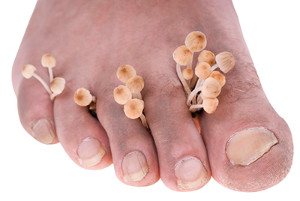 The area of the foot that is most often affected with athlete’s foot is between the toes. This condition is typically caused by a fungal infection that enters the body through tiny cracks in the skin. It generally thrives in warm and moist environments, that include public pools, shower room floors, and surrounding areas. Some patients have existing medical conditions and may make them more likely to contract athlete’s foot. These may include poor circulation, skin conditions such as eczema, or sweaty feet. There are methods that can be implemented which may help to prevent athlete’s foot. These can consist of wearing appropriate shoes while in public areas, frequently washing socks and bedding, and to avoid sharing socks and shoes. For mild cases of athlete’s foot, treating the affected area with an antifungal spray may provide moderate relief. If this condition becomes severe, it is suggested to schedule an appointment with a podiatrist who can properly treat this condition.
The area of the foot that is most often affected with athlete’s foot is between the toes. This condition is typically caused by a fungal infection that enters the body through tiny cracks in the skin. It generally thrives in warm and moist environments, that include public pools, shower room floors, and surrounding areas. Some patients have existing medical conditions and may make them more likely to contract athlete’s foot. These may include poor circulation, skin conditions such as eczema, or sweaty feet. There are methods that can be implemented which may help to prevent athlete’s foot. These can consist of wearing appropriate shoes while in public areas, frequently washing socks and bedding, and to avoid sharing socks and shoes. For mild cases of athlete’s foot, treating the affected area with an antifungal spray may provide moderate relief. If this condition becomes severe, it is suggested to schedule an appointment with a podiatrist who can properly treat this condition.
Athlete’s Foot
Athlete’s foot is often an uncomfortable condition to experience. Thankfully, podiatrists specialize in treating athlete’s foot and offer the best treatment options. If you have any questions about athlete’s foot, consult with one of our podiatrists from Romeo Foot & Ankle Clinic. Our doctors will assess your condition and provide you with quality treatment.
What Is Athlete’s Foot?
Tinea pedis, more commonly known as athlete’s foot, is a non-serious and common fungal infection of the foot. Athlete’s foot is contagious and can be contracted by touching someone who has it or infected surfaces. The most common places contaminated by it are public showers, locker rooms, and swimming pools. Once contracted, it grows on feet that are left inside moist, dark, and warm shoes and socks.
Prevention
The most effective ways to prevent athlete’s foot include:
- Thoroughly washing and drying feet
- Avoid going barefoot in locker rooms and public showers
- Using shower shoes in public showers
- Wearing socks that allow the feet to breathe
- Changing socks and shoes frequently if you sweat a lot
Symptoms
Athlete’s foot initially occurs as a rash between the toes. However, if left undiagnosed, it can spread to the sides and bottom of the feet, toenails, and if touched by hand, the hands themselves. Symptoms include:
- Redness
- Burning
- Itching
- Scaly and peeling skin
Diagnosis and Treatment
Diagnosis is quick and easy. Skin samples will be taken and either viewed under a microscope or sent to a lab for testing. Sometimes, a podiatrist can diagnose it based on simply looking at it. Once confirmed, treatment options include oral and topical antifungal medications.
If you have any questions, please feel free to contact our offices located in Washington and Shelby Townships, MI . We offer the newest diagnostic and treatment technologies for all your foot care needs.
How to Deal with Athlete's Foot
Athlete’s foot is a type of fungal infection that affects the skin on the feet. It is caused when the tinea fungus grows on the foot. It is possible to catch the fungus through direct contact with someone who has it or by touching a surface that is contaminated with it. This type of fungus thrives in warm, moist environments such as showers, locker room floors, and swimming pools. Your risk of getting it may also increase by wearing tight-fitting, closed-toe shoes, or by having sweaty feet.
Symptoms of athlete’s foot include itching, stinging or burning sensations between the toes. You may also experience toenails that are discolored, thick, crumbly, or toenails that pull away from the nail bed.
Your podiatrist may diagnose athlete’s foot by detecting these symptoms or by doing a skin test to see if there is a fungal infection present. The most common exam used to detect Athlete’s foot is a skin lesion potassium hydroxide exam. To use this method, your doctor will scrape off a small area of the infected skin and place it into potassium hydroxide. The potassium hydroxide will destroy the normal cells and leave the fungal cells untouched so that they are visible under a microscope.
There are a variety of treatment options for athlete’s foot. Some medications are miconazole (Desenex), terbinafine (Lamisil AT), clotrimazole (Lotrimin AF), butenafine (Lotrimin Ultra), and tolnaftate (Tinactin). While these options may be able to treat your fungus, it is best that you consult with a podiatrist in order to see which treatment option may work best for you.
In some cases, Athlete’s foot may lead to complications. A severe complication would be a secondary bacterial infection which may cause your foot to become swollen, painful, and hot.
There are ways that you can prevent athlete’s foot. Washing your feet with soap and water each day and drying them thoroughly is an effective way to prevent infections. You also shouldn’t share socks, shoes, or towels with other people. It is crucial that you wear shower sandals in public showers, around swimming pools, and in other public places. Additionally, you should make sure you wear shoes that can breathe and change your socks when your feet become sweaty. If you suspect that you have Athlete’s foot, you should seek help from a podiatrist as soon as possible.
Are You Suffering From Ingrown Toenails?
Why Are Flip Flops Worn?
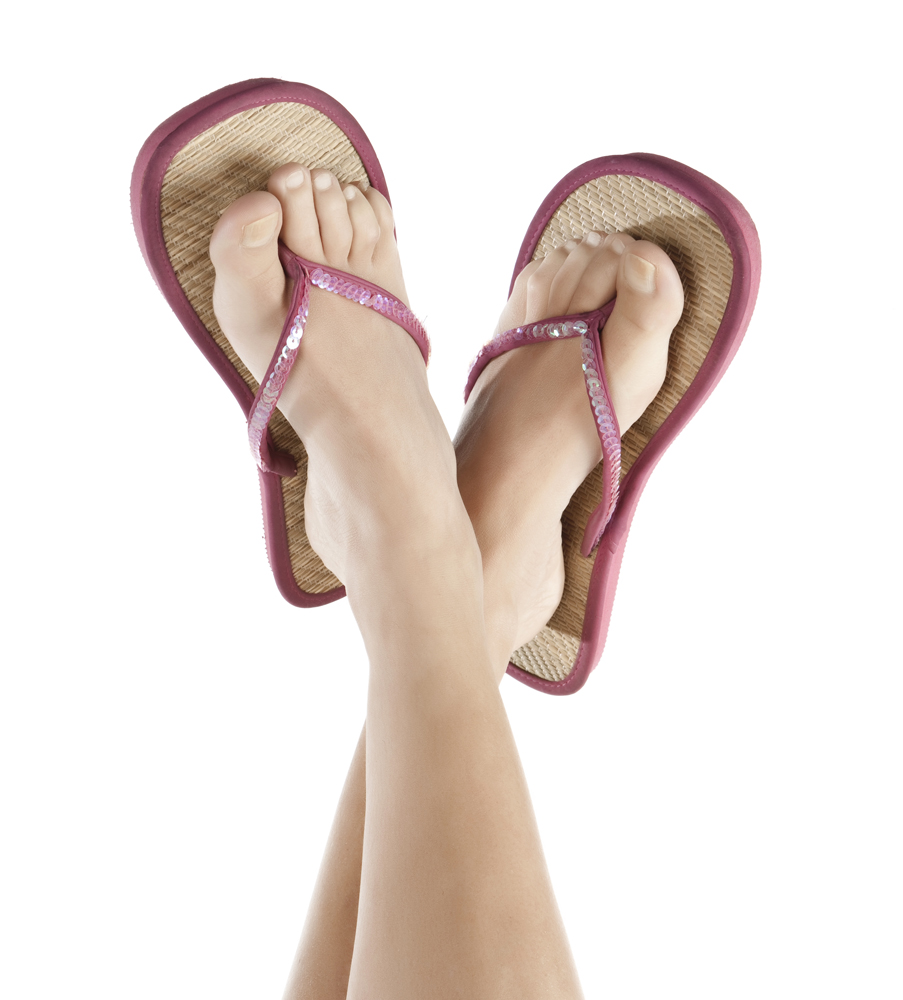 Many people find it appealing to wear flip flops during the warm months. Despite being generally inexpensive and easy to slip into, they can cause damage to the feet. Ankle sprains are common when flip flops are worn, and this happens as a result of minimum support that this type of shoe offers. Additionally, the style of walking is altered as the toes grasp the front of the shoe in order to keep them on. Research has indicated there are specific types of flip flops that may have more support than others. These include shoes that have an outer sole that is stable and lightweight, which aids in providing adequate shock absorption. Choosing a shoe that has a strap typically helps the foot to stay in place. If you are interested in wearing flip flops, it is suggested that you consult with a podiatrist who can guide you in choosing the right shoe.
Many people find it appealing to wear flip flops during the warm months. Despite being generally inexpensive and easy to slip into, they can cause damage to the feet. Ankle sprains are common when flip flops are worn, and this happens as a result of minimum support that this type of shoe offers. Additionally, the style of walking is altered as the toes grasp the front of the shoe in order to keep them on. Research has indicated there are specific types of flip flops that may have more support than others. These include shoes that have an outer sole that is stable and lightweight, which aids in providing adequate shock absorption. Choosing a shoe that has a strap typically helps the foot to stay in place. If you are interested in wearing flip flops, it is suggested that you consult with a podiatrist who can guide you in choosing the right shoe.
Flip-flops can cause a lot of problems for your feet. If you have any concerns about your feet or ankles, contact one of our podiatrists from Romeo Foot & Ankle Clinic. Our doctors will assist you with all of your foot and ankle needs.
Flip-Flops and Feet
Flip-flops have managed to become a summer essential for a lot of people. While the shoes may be stylish and easy to slip on and off, they can be dangerous to those who wear them too often. These shoes might protect you from fungal infections such as athlete’s foot, but they can also give you foot pain and sprained ankles if you trip while wearing them.
When Are They Okay to Wear?
Flip-flops should only be worn for very short periods of time. They can help protect your feet in places that are crawling with fungi, such as gym locker rooms. Athlete’s foot and plantar warts are two common fungi that flip-flops may help protect your feet against.
Why Are They Bad for My Feet?
These shoes do not offer any arch support, so they are not ideal for everyday use. They also do not provide shock absorption or heel cushioning which can be problematic for your feet. Additionally, you may suffer from glass cuts, puncture wounds, and stubbed toes since they offer little protection for your feet.
More Reasons Why They Are Bad for Your Feet
- They Slow You Down
- May Cause Blisters and Calluses
- Expose Your Feet to Bacteria
If you have any questions, please feel free to contact our offices located in Washington and Shelby Townships, MI . We offer the newest diagnostic and treatment technologies for all your foot care needs.
Flipping Out About Flip Flops
Although it may be tempting to wear flip-flops in warm weather, they are not the best choice of footwear for your feet. Flip-flops may be ideal for the beach, pool, spa, and shared showers, but you should avoid wearing them unless it is completely necessary.
Flip-flops only have a small strip of fabric holding your foot in place, but your toes need a better grip to keep your foot in place. The repetitive gripping can lead to an overuse of your muscles, which could result in tendinitis. This is only one of the many problems that stem from wearing flip-flops too often.
Flip flops aren’t good for extensive walking because they fail to offer arch support, heel cushioning, or shock absorption. As a result, people who wear flip flops are at a higher risk of experiencing an ankle sprain. Additionally, these shoes offer little protection for your feet, putting those who wear them at a greater risk for stubbed toes, glass cuts, and puncture wounds.
Although flip flops aren’t recommended for everyday use by anyone, it is especially important for diabetics to avoid them. A diabetic foot injury can easily become very serious, and it may even lead to amputation.
If you are experiencing pain from wearing flip-flops, you shouldn’t be hesitant to replace them with a more comfortable shoe that offers more support. If your flip-flop foot pain doesn’t go away, you should seek assistance from a podiatrist right away. It is possible that you may have a more serious foot problem such as a stress fracture or arthritis.
Stress Fractures of the Foot and Ankle
Our bones are important aspects of our body and they are constantly changing. The heavier the workload for a bone, the more likely it is that calcium will be placed in it. When a bone isn’t used often, there won’t be much calcium within it. When stress from repetitive loads prevent the bone from being able to repair itself, cracks will start to form. Stress fractures are defined as cracks in a bone that result from repetitive force, such as overuse.
The most common cause of stress fractures is a sudden increase in intensity and duration of physical activity. For example, if you begin to run long distances without working your way into doing so, you will be more likely to develop a stress fracture.
Common symptoms of stress fractures are pain and swelling near the weight bearing area on the injured bone. When initial x-rays are performed, it is possible that the fracture will not show up. However, once the stress on the area continues, the damage will increase, and the fracture will be severe enough to show up on an x-ray. Certain parts of the foot are more likely to develop stress fractures than others. Areas that typically have these fractures are: the metatarsals, the navicular bone, the calcaneus, tibia, and fibula.
Since women are at an increased risk of developing osteoporosis, they are twice as likely as men to sustain a stress fracture. Additionally, old age causes a decrease in bone mineral density which is why elderly people are also likely to develop these fractures.
It is important for you to be professionally diagnosed by a podiatrist if you suspect you have a stress fracture, because there are other injuries that can easily be mistaken for a fracture. Sprains, strains, shin splints, plantar fasciitis, and Morton’s neuroma can all easily be mistaken for stress fractures in the foot. Your podiatrist will likely ask you a series of questions to determine what type of pain you are experiencing. These questions will help your doctor identify whether you have a stress fracture.
The best method of treatment for a stress fracture is rest. Additionally, a walking boot, cast, or crutches, will help rest the area that is injured. The typical healing time for stress fractures is 4-12 weeks, however this depends on which bone is involved.
